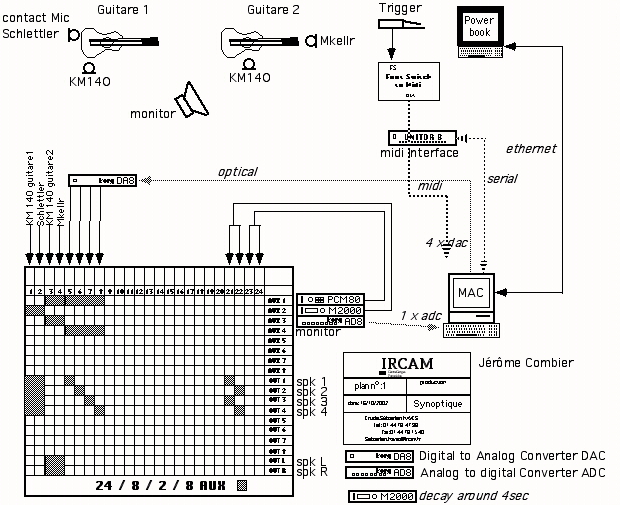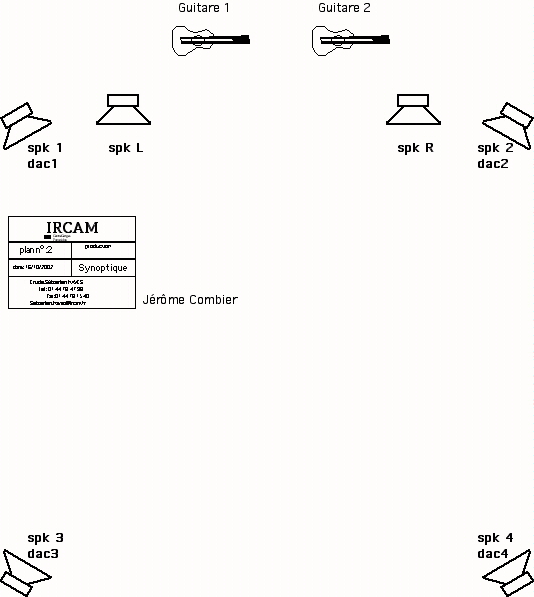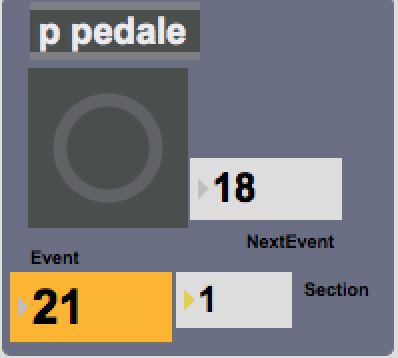Table of contents
Documentation date: 4 mai 2012
Version state
Valid
Validation date: 3 mai 2018
Version documentalist
Version realisation
- Grégoire Lorieux (Computer Music Designer)
Upgrade Motivation
Max 6 version, enhanced controls
Other version(s)
Detailed staff
- guitare
Electronic equipment list
Computer Music Equipment
-
2 MacBook Pro - Apple Laptops
(Apple)
one on stage for the guitar player -
1 Max 6 - Max
(Cycling74)
-
1 Footswitch / Sustain Pedal - Footswitch / Sustain Pedal
Audio Equipment
-
2 KM140 - Dynamic Microphones
(Neumann)
or equivalent -
1 MKE 2-2R Red Dot - Lavalier Microphones
(Sennheiser)
or equivalent -
1 Schertler Harp - Contact Microphones
(Schertler)
or equivalent -
2 Loudspeaker - Loudspeakers
guitar amplification
Work related information
Premiere
- 17 octobre 2002, France, Paris, Ircam
Publisher :
- Lemoine
Realisation
- Jean Lochard
Work length
- 8 mn
Useful links on Brahms
- Kogarashi, le premier soupir des fantômes pour guitare et électronique (2002), 8mn
- Jérôme Combier
| File | Author(s) | Comment | |
|---|---|---|---|
| Download [306,8 Mio] | Patch Kogarashi.zip | Lorieux | contains the score and a recording of the piece |
Instructions
General setup :

Loudspeaker setup :

Note : Add another computer on stage to display chronometer + event numbers. Use the Patch-computeronStage folder on it.
Initialization routine :
- open the main patch _KOGARASHI-Max6.maxpat with Max version > 6.1
- click RESET
- click OSC ON, enter distant IP (localhost if same computer), send IP test (distant computer blinks ?)
- check pedal (midi controller, test in test mode, check polarity, put in use mode)
- dac ON
- to trigger events, press pedal or space key
ADC/DACS :
- Dac 1 2 3 4 : audio-files
- Dac 5 6 7 8 : vocoders (post panr4~)
- Dac 5 6 : Shift1
- Dac 5 6 7 8 : Shift2
- Dac 7 8 : Shift3
patch presentation

Score Following
The yellow number box displays the number of the current event. Use the interactive number box Section to get any section
The button Next Event allow you to activate the next event.
The number box Go to Event allows you to select a given event. This event will be played at the next Next Event button activation

Score Following Part
Score following - PowerBook Patch
This patch displays the time and number of the current event for the performers
You may have to change the IP adress of the on-stage computer in the p osc subpatcher of the main patch.

PowerBook Patch
© IRCAM

This documentation is licensed under a Creative Commons Attribution-NonCommercial-NoDerivatives 4.0 International License.
Program note
« Le vent d’hiver dit Kogarashi (celui qui sèche les arbres) est la bise dont le souffle emporte les dernières feuilles. Exemple parfait d’une violence extrême, il n’a pourtant ni forme ni couleur, n’étant visible que par ce qu’il produit »1. Les fantômes sont ceux du Roi Lear (acte III) qui résonnent dans son esprit, fantômes inexpugnables errant sur la lande où Lear se perd absolument. Force surnaturelle, cette mythologie – croit-il – le soumet. D’eux ne parviennent que les soupirs portés par le vent. Un vent qui charrie le souffle de voix inconnues, ou bien s’agit-il de sa propre voix (« soufflée, ma voix revient vers moi » dit le poète Japonais 2). Un vent qui est l’espace devenu audible, mais un espace où le sol se dérobe, où tout se confond, bruits et sons, où ciel devient terre et terre devient ciel. Lear y meurt et y naît à la fois. « Le premier soupir des fantômes, c’est le dernier soupir des vivants » 3. * René Sieffert, Le Faucon impatient, Presses Orientalistes de France, Paris, 1994. * Meisetsu (1847-1926) dans L’Hôte, l’invité et le chrysanthème blanc, Haikus d’automne, éditions Moudarren, Millemont (France), 1990. * Jacques Dars, Aux portes de l’enfer, éditions Philippe Piquier, Arles, 1984.Jérôme Combier.
Version documentation creation date: None, update date: 6 mai 2021 15:10